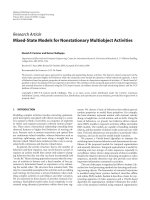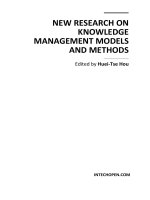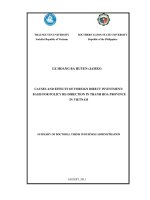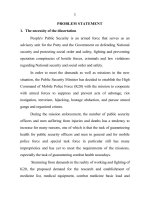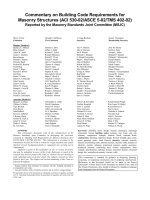Research on building ideal models for community forest at xuan le commune thanh hoa province
Bạn đang xem bản rút gọn của tài liệu. Xem và tải ngay bản đầy đủ của tài liệu tại đây (494.32 KB, 35 trang )
MINISTRY OF AGRICULTURE AND RURAL DEVELOPMENT
VIETNAM NATIONAL UNIVERSITY OF FORESTRY
STUDENT THESIS
RESEARCH ON BUILDING IDEAL MODELS
FOR COMMUNITY FOREST AT XUAN LE COMMUNE,
THANH HOA PROVINCE
Major: Natural Resources Management
Code: D850101
Faculty: Forest Resources and Environmental Management
Student: Hoang Phuong Anh
Class: K58A Natural Resources Management
Student ID: 1353090984
Course: 2013 - 2018
Advanced Education Program
Developed in collaboration with Colorado State University, USA
Supervisor: Assoc. Prof. Pham Minh Toai
Ha Noi, 2018
ACKNOWLEDGEMENT
Many people contributed during the process of planning, implementation, and writing
of this thesis. For supervision of the thesis, I especially thank to Assoc. Prof. Pham Minh Toai
for his technical supports, helpful suggestions and enthusiastic encouragements. Without his
thoughtful, patient guidance through every step of my research, this thesis could not have
been realized.
I sincerely thank to Vietnam National University of Forestry has given me an
opportunity to apply the knowledge I learned from the school. I have got many new and
useful experiences that are helpful for my future work.
I would like to extend my thanks to Mr. Cam Ba Hung, Vice Head of Xuan Le
Commune Administration, as well as respective staff members for accepting me as an
apprentice and supporting me with the enthusiastic guidance to collected data when I work at
Xuan Le Commune.
Special thanks to my sister Ms. Rose for helping me correct language mistakes of the
thesis.
Finally, I wish to express my gratitude to my beloved family for their boundless
patience and love.
i
ABSTRACT
Xuan Le commune is within a mountainous area located in the west of Thuong Xuan
district, Thanh Hoa province with abundant forest resources. However, there is unavailability
of growth and yield data for Xuan Le Commune, therefore, the forest resources assessment is
crucial in order to elaborate ideal stem number-diameter distribution (so-called ideal models),
needed during the process of data analysis and forest management planning. It’s also the
method facilitating the identification of a standard for participatory forest resource assessment
and management planning. Thus, the present work aimed to provide a basis elaboration of
ideal stand models for community forest at Xuan Le commune. The results show the two ideal
models have been built based on forest assessment and demand of local forest users on timber
exploitation. There are three forest statuses in Xuan Le Commune, namely young-regenerated
forest after shifting cultivation (IIa), regenerated forest after exploitation (IIb) and natural
forest already exploited (IIIa1). The preferable harvestable diameters about 33 cm as a
minimum size. In degraded forest stand, the mean annual diameter-increment is 1, 01 cm,
diameter-class widths roughly resembling time of passages of 5 years, the lowest diameterclass has been set at < 6 cm, the largest diameter-class has been set at > 32.9 cm DBH . In
matured forest stand, the mean annual diameter-increment is 0,5 cm, diameter-classes width
roughly representing 10 year growth-intervals, the largest diameter-class has been set at >
39.9 cm DBH.
-
ii
TABLE OF CONTENT
ACKNOWLEDGEMENT ........................................................................................................... i
ABSTRACT ............................................................................................................................... ii
TABLE OF CONTENT ............................................................................................................iii
LIST OF ABBREVIATIONS .................................................................................................... v
LIST OF TABLES .................................................................................................................... vi
LIST OF FIGURES ..................................................................................................................vii
1. INTRODUCTION .................................................................................................................. 1
2. GOAL, OBJECTIVES AND METHODS ............................................................................. 3
2.1. Goal ..................................................................................................................................... 3
2.2. Objectives ............................................................................................................................ 3
2.4. Methodology........................................................................................................................ 3
2.4.1. Elaboration of ideal model ............................................................................................... 3
2.4.2. Plot establishment ............................................................................................................. 4
2.4.3. Annual growth increment and suitable diameter – class .................................................. 4
2.4.4. Suitable basal area and stem numbers in single diameter-classes .................................... 8
3. STUDY SITE CHARACTERISTICS .................................................................................. 12
3.1. Natural conditions ............................................................................................................. 12
3.2. Socio-economic conditions................................................................................................ 13
3.2.1. Ethnic groups and population ......................................................................................... 13
3.2.2. Economic condition ........................................................................................................ 13
4. RESULTS ............................................................................................................................. 14
4.1. Forest statuses in the study area ........................................................................................ 14
4.2. Demand of local forest user groups on timber exploitation .............................................. 15
4.3. Annual growth increments of forest statuses ..................................................................... 16
iii
4.3.1. Degraded forest stands.................................................................................................... 16
4.3.2. Matured forest stands ..................................................................................................... 18
4.4. Stem numbers in single diameter-classes, suitable basal area and ideal models for
community forest in Xuan Le commune .................................................................................. 20
4.5. Proposed solutions for community forest management .................................................... 24
5. CONCLUSION .................................................................................................................... 25
REFERENCES
iv
LIST OF ABBREVIATIONS
CBFM
Community-Based Forest Management
CF
Community forest
CFM
Community forest management
DBH
Diameter at breast height (1,3 m)
Ha
Hectare
NTFP
Non-timber forest products
RECOFTC
The Center for People and Forests
v
LIST OF TABLES
Table 2.1. Overview of the single steps leading to the calculation of diameter-classes,
representative of equal times of passage .................................................................................... 6
Table 4.1. List of species included in the measurement of annual growth rings from former
shifting cultivation areas ........................................................................................................... 16
Table 4.2. List of species included in the measurement of annual growth rings from matured
forest stands. ............................................................................................................................. 19
Table 4.3. Stem number and basal area of single diameter-classes representing the ideal stand
model for degraded forest sites................................................................................................. 21
Table 4.4. Stem number and basal area of single diameter-classes representing the ideal stand
model for mature forest sites .................................................................................................... 22
vi
LIST OF FIGURES
Figure 2.1. Layout of plot establishment .................................................................................... 4
Figure 2.2. The sequence of tasks necessary for the determination of suitable diameter-class
widths as input parameters for ideal models............................................................................... 5
Figure 2.3. The sequence of task necessary for the determination of suitable basal area and
stand structure as input parameters for ideal models .................................................................. 9
Figure 3.1. Map of Xuan Le Commune.................................................................................... 12
Figure 4.1. Diameter/age estimation derived from annual growth ring measurement of 14
samples from degraded forest sites in Xuan Le commune ....................................................... 18
Figure 4.2. Diameter/age estimation derived from the measurement of annual growth rings of
7 sampled from matured forest sites in Xuan Le commune. From the resulting graph,
diameter- classes have been derived roughly resembling equal times of passages. ................. 20
Figure 4.3. Ideal stem number-diameter distribution for matured forest stands ...................... 23
Figure 4.4. Ideal stem number-diameter distribution for degraded forest stand ...................... 23
vii
1. INTRODUCTION
Forests play an important role both in its social and environmental functions especially
concerning the provision of timber and non-timber forest products, its watershed protection
functions and as well as the role as habitat for variety of animal and plant species. Another
vital feature of forestry is its role in poverty alleviation and income improvement for people,
particularly local people who live near the forests. The challenge of forest resource
management in Vietnam is to achieve a balance between these socio-economic functions of
the forest and its environment functions.
A new phase in the development of forest policies and programs was came into use in
the 1970s, which made significant progress to the present Community-based forest
management (CBFM) program and strategy, and since then become a popular intervention
across Asia and Africa. CBFM is government-approved form of forestry practices involving
direct forest users in common decision-making processes and implementation of forestry
activities, and as such it requires decision-making autonomy to the direct forest users in
setting objectives, local control in forest management and utilization, and ownership of the
benefits of the forest (Bowler et al., 2012) [2]. It also can be considered as a state-community
forest management strategy aiming to improve livelihoods of forest user, reduce poverty,
conserve natural resources, and promote good governance and decentralization. CBFM
includes “initiatives, sciences, policies, institutions and processes that are intended to increase
the role of local people in governing and managing forest resources” (RECOFTC, 2013) [3],
then encourage indigenous community in protecting forests as well as help them to get benefit
from those forest resources. CBFM emerged as a search for alternative and less contested
approaches to forest management in parallel with a growing international interest in
participatory development and linkages between land rights movements and the
environmental movement. According to Runge (1986) [7], CBFM played an important role in
1
nurturing scarce natural resources. Local communities have been managing forests for a long
time, that is exploiting, sustaining and manipulating them for productive products. They base
their forest management in a traditional knowledge and own rules sufficient to sustain the biophysical condition of their forests resulting long-term ecological sustainability in compatible
with locally set priorities (Hayes and Persha, 2010) [5].
However, the major shortcoming of this approach for elaboration of CBFM consisted in the
fact that the management plans were not based on forest inventory data. Forest inventory forms the
basis for sustainable forest management. The purpose is to assess the quantity and quality of forest
resources available for management to develop an effective forest management plan, that can
satisfying the demand of the forest user in terms of forest products while at the same time ensuring
sustainability of forest resources (Wode, 2003) [13]. For suitable forest management, especially for
decision maker, there is a need of the development of an overall management goal or standard,
which can be compared against the real situation. However, until now forest inventories are carried
out only the national level to provide data for forest policy and national statistic but are not suitable
and not intended to provide detailed data on growth and yield characteristics for sustainable forest
management at the individual stand level.
Xuan Le is a commune in Thuong Xuan district, Thanh Hoa province, Vietnam. It has
an area of 98.94 km², with a population of 3,614 people and a population density of 37
persons/km². Xuan Le commune is characterized by a rather low standard of education and
high degree of poverty. It can only be accessed crossing many rivers and small streams,
resulting in a poor connection to regional market but surpassing endowment with natural
forest, especially regarding matured forest stands. Being aware of the important role of an
overall management standard based on suitable forest resources assessment for sustainable
forest planning, I decided to conduct a thesis titled “Research on building ideal models for
community forest at Xuan Le commune, Thanh Hoa province”.
2
2. GOAL, OBJECTIVES AND METHODS
2.1. Goal
The general goal is to assess the quantity and quality of forest resources for
management in the context of community-based forest management in Xuan Le commune,
Thanh Hoa province.
2.2. Objectives
- To assess current status of forest statuses in Xuan Le commune;
- To propose ideal models for each forest status and solutions for community forest
management;
2.3. Expected Results
- Current forest statuses;
- The demand of timber exploitation of local user groups;
- The diameter/age derived form annual growth rings of two ideal forest stands;
- The suitable basal area of two ideal forest stands;
- Stem numbers in single diameter classes;
- Ideal model estimation;
- Solutions for community forest management.
2.4. Methodology
2.4.1. Elaboration of ideal model
The ideal model aims at representing a managed natural forest combining protection
and production functions at the same time. Ideal models have to be elaborated for each forest
type separately. Thus, the initial task of model establishment has to be the assessment of
overall forest types present in Xuan Le commune. Subsequent tasks, namely adjustment of
diameter-classes, estimation of basal area and stand structure have to be carried out for each
forest type separately.
3
2.4.2. Plot establishment
Two one-ha plots were established in two forest types: regenerated forest and
degraded forest. Each plot covers an area 10,000 m2 (one hectare) and is divided into 25 subplots of 400 m2 each (20m x 20m).
20 m
21
22
23
24
25
16
17
18
19
20
11
12
13
14
15
6
7
8
9
10
1
2
3
4
5
20 m
Figure 2.1. Layout of plot establishment
2.4.3. Annual growth increment and suitable diameter – class
a, Data collection
Elaboration of suitable diameter-class widths represents a necessary task of the
preliminary forest survey. Figure 2.2 presents a flowchart of various pathways leading to the
determination of diameter-classes in local context.
4
Figure 2.2. The sequence of tasks necessary for the determination of suitable diameterclass widths as input parameters for ideal models
The division of diameter-classes is very important regarding the facilitation of data
collection and analysis by local people, enabling them to gain knowledge about the structure
of their forests. Apart from the static picture of the actual forest structure, the stem numberdiameter distribution can additionally be used as a dynamic model to predict forest growth
and yield. By setting the diameter classes to a constant time of passage it is assumed that all
trees of the forest stand grow into the next higher diameter-class within the respective time
period. Ideal models are needed during the participatory elaboration of 5-year management
5
plans for respective forest. The time of passage should be set in accordance with the planning
period (5 or 10 years), facilitating the determination of the number of harvestable trees in
respective diameter-classes during the process of management plan elaboration.
a, Data analysis
After the annual increment measurements of representative samples have been
completed, the data has to be analyzed. The single steps of data analysis, leading to the
determination of diameter-classes representative of equal times of passage, are outlined in
table 2.1.
Table 2.1. Overview of the single steps leading to the calculation of diameter-classes,
representative of equal times of passage
Step
1
Task
Calculate the arithmetic mean of respective annual diameter increments of all
samples (referred to as AIn).
2
Add up the arithmetic mean values of respective annual diameter increments to
obtain cumulative increment values for each year (referred to as CDIn).
3
Using the CDIn values to identify diameter-classes that are representative of equal
time of passages (i.e. sum up five consecutive CDIn values to obtain a diameter-class
representative of a 5 year growth interval)
The initial step of data analysis comprises the calculation of mean annual diameterincrements, which are arrived at by adding up the respective annual increments of all samples
and dividing the sum by the sample size:
6
Subsequently, the mean annual diameter-increments (annual growth increment) are
added up in order to arrive at the cumulative diameter-increment:
Based on the cumulative diameter-increment, diameter-class widths are determined
representative of equal times of passages.
b, Interview of local forest user groups
Elaborated ideal models are adequately adopted to accommodate the demand of local
forest user groups, while at the same time ensuring the maintenance of the protection function
of managed natural stands. In order to have detail information about the respective demand of
local forest users, namely women and men who are frequently collect and utilize different
forest products have to be questioned in each preliminary survey.
The adjustment of diameter-classes is mainly geared to yield equal times of passage.
However, the minimum harvestable diameter for the largest timber dimension demanded by
local forest users is of very importance, as it determines the largest diameter-class of the
model. In order to acquire this information, an assessment of the forest product demand
should be carried out. It is important to realize that despite the fact that the upper diameterclass limit is subject to the demand of the forest user group, villagers are at no point urged to
7
cut trees if reaching the respective minimum harvestable diameter. Instead, freedom over the
decision to harvest trees at the desired point in time is maintained, as long as the limits
postulated by the ideal model are obeyed. In case forest users decide to let too many trees
grow to mature size, stem numbers in the lower diameter classes are expected to decline
below the limits indicated by the respective ideal model. Therefore, necessary interventions
will become apparent, comparing the actual stem number diameter distribution of the forest
with the one of the respective ideal model.
2.4.4. Suitable basal area and stem numbers in single diameter-classes
a, Data collection
Basal area of a forest is defined as the sum of the cross-sectional areas of all trees,
measured in the breast height (at 1,3 meters), commonly expressed as m2 per hectare. Basal
area is a simple and useful silvicuture measure of yield. Tasks needed to adjust the basal area
as well as stand structure are present in Figure 2.3.
8
Figure 2.3. The sequence of task necessary for the determination of suitable basal area
and stand structure as input parameters for ideal models
It was estimated a suitable basal area of 30m2 for managed natural forest stands in Son
La province, using scientific sources from in- and outside Vietnam, as well as results from
participatory forest inventories (Wode 2003) [15]. Similarities regarding the climate and
vegetation of Thanh Hoa and Son La, mainly due to the proximity of both provinces, rendered
the adoption of the basal area value for managed natural forests in Thanh Hoa possible.
9
a, Data analysis
All trees, saplings, and seedlings contained within a sample plot are enumerated,
measuring their DBH as well as recording the species affiliation. Firstly, the data is grouped
into 1 cm diameter classes. Then the total basal area for each plot is calculated by summing
the basal areas in each diameter class, and the average basal area per hectare calculated by
proportion to plot area.
To arrive at an average stem number per diameter-class and hectare, the data is
grouped according to the chosen diameter-classes. Stem numbers in the single diameterclasses of the sample plots are extrapolated to yield per hectare values, dividing the respective
stem number by the sample plot size. Subsequently, the per hectare values for each diameterclass of all sample plots are summed up and the resulting figure is divided by the amount of
sample plots in the forest stand.
10
b, Adjustment of basal area and stand structure:
The acquired basal area, again emphasizing that sample plots have to be located in
forest patches representative of good growing conditions, sets the frame for the stem numberdiameter-class distribution. The average stem numbers per diameter- classes obtained from
the sample plot data can furthermore serve as a reference for the elaboration of ideal stand
models.
To finally arrive at a respective ideal stand model, stem numbers in the single
diameter-classes have to be determined, strictly obeying the law of diminishing stem numbers
with increasing diameter-class. Meanwhile, issues from the interviews of local forest users
have to be adequately considered, ensuring the models suitability within the context of
community forestry.
11
3. STUDY SITE CHARACTERISTICS
3.1. Natural conditions
Xuan Le commune is a mountainous area located in the west of Thuong Xuan district,
Thanh Hoa province. It’s about 90 km southwest Thanh Hoa city
Figure 3.1. Map of Xuan Le Commune
(Sources: Ministry of Science and Technology, [2000])
12
Topography: Xuan Le commune has various topographical characteristics with an
average height of 500-700m with many hills. The topography causes soil erosion.
Climate: Average temperature is 22-24°C, the hottest temperature is 37-40oC, the
coldest temperature is 1oC – 3oC. Average rainfall is 1,600-2,000mm and distributed
unequally. Average humidity is 85 – 86%. The North East monsoon lasts from October to
April next year. Hot, dry Southwest wind from April to July. The hot, humid and rainy
weather are suitable for growing plants.
3.2. Socio-economic conditions
3.2.1. Ethnic groups and population
There are 3 ethnic groups living in Xuan Le Commune, in which Thai people account
for 55%, Kinh people is 41%, Muong people is 3.2%. According to demographic statistics of
2016, the total population is 3614 people. The population density is 37 people / km².
3.2.2. Economic condition
Xuan Le is a mountainous commune with difficult economic condition. The main
incomes of local people are mainly based on forest and agriculture production. The forestry,
agriculture and fisheries sector accounted for 31.3%, industry - handicrafts - construction
39.2%, trade and services 29.5%.
13
4. RESULTS
4.1. Forest statuses in the study area
In general, three overall forest statuses could be identified in Xuan Le commune, there
are young regenerated forest after shifting cultivation (IIA), regenerated forest after
exploitation (IIB), so called matured forest and natural forest already exploited (IIIA1:
degraded forest). The former recovering from shifting cultivation, while the latter represent
more matures forest stands, generally situated farther from the settlement area, legally
classified as protection forest.
There are major differences between those statuses of forest stands regarding their species
composition, with typical species found in IIA and IIB being Ginoniera sp. (Ngat), Engelhardtia
drysolepsis (Cheo tia) and Cassia pinnata (Rang rang mit). On the contrary, the matured forests
accommodate very valuable, but slower growing species such as Shorea roxburghii (Sen), Vatika
tonkinensis (Tau), Fokienia hodginsii (Po mu), Erythrophorum fordii (Lim), Diospyros mun (Mun),
Cinnamomum albiforum (Re) and Mangletia fordiana (Vang tam).
Forest structure differs accordingly between the two forest types. In areas classified as
IIA, bigger-sized trees are generally lacking, resulting in a rather open canopy and dense
underbrush. Those areas frequently form small-scale mosaic patterns with denuded or entirely
grass-infested spots. The abundance of pole-sized trees (15-20 cm in DBH) is somewhat
higher in areas classified as IIB, leading to more readily closed canopies. However, the
vertical structure of those stands consists only two strata with a great proportion of the area
being significantly infested by bamboo, weeds, and climbers. Where the matured forest sites
are undisturbed, emergent trees are sticking out of a closed canopy and the vertical stand
structure is frequently being divided into three or four main strata. Bamboo and weeds, if
encountered at all, are not very abundant in those forest stands.
14
4.2. Demand of local forest user groups on timber exploitation
Several interviews have been carried out during the stay in Xuan Son village, Xuan Le
commune. The interviews has been taken to include people of both gender as well as varying
age groups in order to obtain a broad picture about the demand for timber and non-timber
forest products.
In general it can be noted, that the timber needed for house construction can at present
only be obtained from the matured forest stands and is generally lacking both in terms of size
as well as preferable species in the areas recovering from shifting cultivation. Nevertheless,
some species found in the degraded forest stands can be used for construction timber but are
often relic trees from former exploitation. Those species include Quercus wallichiana (De
do), Engelhardtia drysolepsis (Cheo tia) and Gironniera sp. (Ngat). Moreover, regarding the
preferable harvestable-diameters for house building, farmers stated that although about 33 cm
can be seen as a minimum size for harvesting, preference is generally given to the biggest
trees, which are only encountered in matured forest stands. Thus, even emergent trees are
logged and transported disregarding their size and weight, as processing is done on-site, using
simple handsaws.
The selection of trees for harvesting is based on suitability criteria like species, stem
form, and diameter. As a result, harvested trees are scattered over the forest area and therefore
the selection procedure has been termed “single tree selection”. One forest user stated that the
timber needed for the construction of each additional house has to be approved by the forest
protection department of Xuan Le commune. After permission for house construction has
been granted, the family can literally go anywhere in order to harvest the required timber.
However, in Xuan Le commune, an old traditional law restricts the building of new houses to
merely two per year, but villagers revealed that some of the logs cut from the matured forest
are also sold to other villages.
15
In terms of quantity, harvestable diameters of about 30-35 cm are most commonly
used for the construction of pillars for the houses (villagers stated that the outer 1,5 to 2,5 cm
of the log would not be utilized and are therefore removed). Smaller size poles (of about 8 cm
up to 20 cm DBH), however, are still cut in the degraded forest stands are used for the
construction of pig-stalls (around 8-12 cm DBH), as well as buffalo-stalls (around 20 cm
DBH). Nevertheless, some forest users indicated that they would still prefer to cut the 20 cm
poles in the matured forest stands, as species that are more durable can be encountered.
4.3. Annual growth increments of forest statuses
The collection of diameter-disc and subsequent analysis of growth rates after sanding
represents a destructive method. The only alternative for the acquisition of stem disc needed
for the measurement of growth rates was to locate stumps of recently cut trees because tree
were not allowed to be logged for the purpose of this survey. The results of the measurements
for the respective forest types (degraded forest and matured forest) are presented below.
4.3.1. Degraded forest stands
As far as the degraded forest stands are concerned, annual growth rings of 14 trees
have been measured. The list of species is presented in table 4.1.
Table 4.1. List of species included in the measurement of annual growth rings from
former shifting cultivation areas
Local name
Latin name
Abundance (n)
Gie con
Quercus areca
1
Xoan dao
Pygenum arboreum
1
Re
Cinnamonum albiforum
1
Man cho
Knema conferta
1
Lim xet
Peltophorum tonkinensis
2
Rang rang
Cassia pinnata
2
16
Gi gai
Castanopsis indica
1
De do
Quercus wallichiana
1
Cheo tia
Engelhardtia drysolepsis
2
Ngat
Gironniera sp.
1
Com tai trau
Not identified
1
The initial step of data analysis comprises the calculation of mean annual diameter
increments for the respective years. This was done by adding up the increments of all the
samples in each respective year and dividing the sum by the sample. Subsequently, in order to
arrive at the cumulative diameter increment for each year, respective mean annual increments
had to be added up. The mean diameter in dependence of the age of sampled species is
displayed in Figure 4.1.
Based on the cumulative diameter increment, diameter-class widths have been
identified, roughly resembling time of passages of 5 years. In other words, with the chosen
diameter-classes it is approximated that the trees grow from one diameter-class into the next
within an average period of five years. Since rings of juvenile wood (i.e. the stem-sections
near the core) have usually been formed under strong competition through neighbors and
young tree may furthermore differ in physiological responses to drought from mature tree
(Worbes 2002) [16], diameter and age are not expected to strongly correlate at juvenile age.
Thus, the lowest diameter-class has been set at < 6 cm, aiming at obtaining accurate ageintervals for the upper diameter-class.
This step is necessary in order to add the dynamic component of forest growth
(allowing for the prediction of yield) to the otherwise static stem number-diameter
distribution.
17

